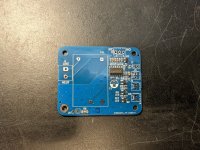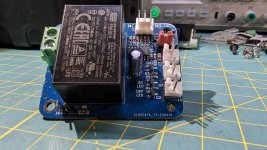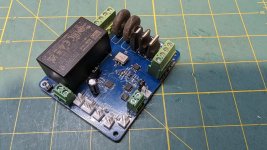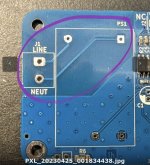Hello all,
Edit: I've changed my pricing a bit. I removed option b, and reduced the price on option c for both switches. See below for details. Quantities are limited.
For sale are two different low-voltage remote switches. The first switch (smaller one #1), was designed out of the need to have a small footprint switch module, that would allow a press ON/OFF function for Ian Canada's DAC stack. More specifically, it was intended to work together with Ian's LinearPi PSU's that already included a Slave Control Input function. Each PSU could be daisy chained together, so that a single press of a switch would power ON (or OFF) all PSU's. I also needed a 'one switch' ON/OFF functionality with LED status for STDBY and ON indicators. Since my recent designs have included mini-ITX computer cases, of various size and shapes, this type of switch would be perfect. The reason for my departure from traditional black and silver audio enclosures to mini-ITX cases, has largely been the fact I was/am getting tired of the same old style cases, and wanted the challenge of developing my case modding skills. And, almost all modern computer cases have a; (1) momentary on/off pushbutton switch, and (2) at least 2 built-in LEDs for POWER and HDD that are brought out to the front panel for easy access and use. These (LEDs) would work perfectly for my application and this switch. All LEDs and switches make use of Molex KK connectors, so that can be user mounted.
Switch #1 - The first switch(below) was designed, and intended to work specifically, with the LinearPi PSU. It does not switch high-voltage, but intended only for low-level voltages. It will work with other low-voltage applications as well. Images are below.


Switch #2 - The second switch is a more traditional switch that includes a 120VAC soft-start feature for large initial current flow. However, the control functions are still low-voltage, and make use of a MO switch, with STDBY and ON LEDs - as used with the smaller switch described above. In addition, to the higher-voltage soft-start feature, this switch also has an independent built-in switch that may, or may not be engaged(user selectable w/jumper) to control an electronic relay with LED indicator when used, or active. This switch behaves as a simple SPST action. For my application, I also wanted a 5VDC supply available as well for use with future projects. The Meanwell (IRM-10-5) power module supplies 5VDC, and is rated at 2.0A. This low-voltage remote switch has found it's way into some of my recent projects, including a new chip-amp, as well as a new preamp board. All SMDs are professionally soldered, except for a couple ICs that I will solder before shipping. A couple images are below.


All LEDs and switches on both boards make use of Molex KK connectors, so they can be user mounted. Instructions/diagram will be included in the your order.
I'm offering these boards in 3 different configurations; (a) PCB with all SMDs (soldered), (b) SMD PCB with bagged T/H components(kit), and (c) fully assembled and tested. Prices are;
Switch #1:
a) $20 - PCB with SMDs soldered
b) $36 - all TH parts bagged
c) $40 - assembled and tested
Switch #2 (soft-start):
a) $30 - PCB with SMDs soldered
b) $50 - all TH parts bagged
c) $55 - assembled and tested
About the pricing... The biggest parts expense is the Meanwell power module. Flat postage of $10.00 for any single switch, any single configuration. Postage cost for 2 or more will be estimated. USA Only. PayPal only.
I only have a few boards of each, so don't miss out. Please PM me if you are interested, or have any questions.
Thanks,
Rick
Edit: I've changed my pricing a bit. I removed option b, and reduced the price on option c for both switches. See below for details. Quantities are limited.
For sale are two different low-voltage remote switches. The first switch (smaller one #1), was designed out of the need to have a small footprint switch module, that would allow a press ON/OFF function for Ian Canada's DAC stack. More specifically, it was intended to work together with Ian's LinearPi PSU's that already included a Slave Control Input function. Each PSU could be daisy chained together, so that a single press of a switch would power ON (or OFF) all PSU's. I also needed a 'one switch' ON/OFF functionality with LED status for STDBY and ON indicators. Since my recent designs have included mini-ITX computer cases, of various size and shapes, this type of switch would be perfect. The reason for my departure from traditional black and silver audio enclosures to mini-ITX cases, has largely been the fact I was/am getting tired of the same old style cases, and wanted the challenge of developing my case modding skills. And, almost all modern computer cases have a; (1) momentary on/off pushbutton switch, and (2) at least 2 built-in LEDs for POWER and HDD that are brought out to the front panel for easy access and use. These (LEDs) would work perfectly for my application and this switch. All LEDs and switches make use of Molex KK connectors, so that can be user mounted.
Switch #1 - The first switch(below) was designed, and intended to work specifically, with the LinearPi PSU. It does not switch high-voltage, but intended only for low-level voltages. It will work with other low-voltage applications as well. Images are below.


Switch #2 - The second switch is a more traditional switch that includes a 120VAC soft-start feature for large initial current flow. However, the control functions are still low-voltage, and make use of a MO switch, with STDBY and ON LEDs - as used with the smaller switch described above. In addition, to the higher-voltage soft-start feature, this switch also has an independent built-in switch that may, or may not be engaged(user selectable w/jumper) to control an electronic relay with LED indicator when used, or active. This switch behaves as a simple SPST action. For my application, I also wanted a 5VDC supply available as well for use with future projects. The Meanwell (IRM-10-5) power module supplies 5VDC, and is rated at 2.0A. This low-voltage remote switch has found it's way into some of my recent projects, including a new chip-amp, as well as a new preamp board. All SMDs are professionally soldered, except for a couple ICs that I will solder before shipping. A couple images are below.


All LEDs and switches on both boards make use of Molex KK connectors, so they can be user mounted. Instructions/diagram will be included in the your order.
I'm offering these boards in 3 different configurations; (a) PCB with all SMDs (soldered), (b) SMD PCB with bagged T/H components(kit), and (c) fully assembled and tested. Prices are;
Switch #1:
a) $20 - PCB with SMDs soldered
c) $40 - assembled and tested
Switch #2 (soft-start):
a) $30 - PCB with SMDs soldered
c) $55 - assembled and tested
About the pricing... The biggest parts expense is the Meanwell power module. Flat postage of $10.00 for any single switch, any single configuration. Postage cost for 2 or more will be estimated. USA Only. PayPal only.
I only have a few boards of each, so don't miss out. Please PM me if you are interested, or have any questions.
Thanks,
Rick
Last edited:
It's assumed that the main IEC power inlet will be fused - as all my project are. After all, the IEC is hot 24/7 unless the master switch (back panel) has been switched off. This little low-voltage remote is used to energize the rest of the circuit from a STANDBY/ON soft-switch on the front panel. I use one of the two versions in all my new projects. Works beautifully.
A local fuse adapted to the low current flowing to the switcher is normally used onboard to protect the wiring/PCB tracks (which are also very thin). This to prevent damage when the switcher goes kaput. An IEC inlet with 16A fuse will not protect this PCB enough. It will protect other stuff and wiring possibly connected to that IEC connector.
Possibly not all buyers are experts so the design should cater for electrical safety. Although uncommon the least is text explaining a fused IEC inlet is mandatory with a xx mA T fuse.
Possibly not all buyers are experts so the design should cater for electrical safety. Although uncommon the least is text explaining a fused IEC inlet is mandatory with a xx mA T fuse.
Last edited:
